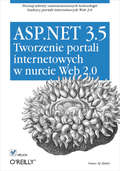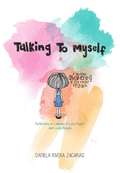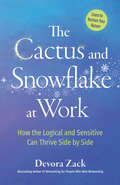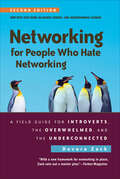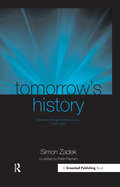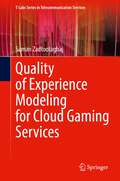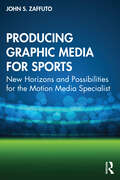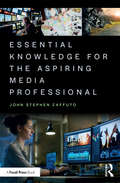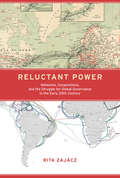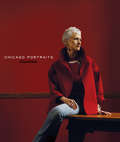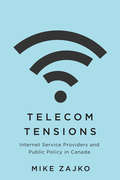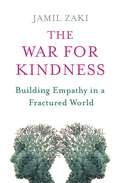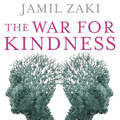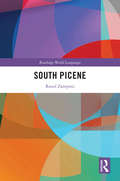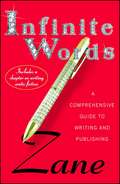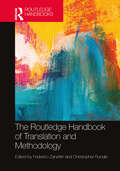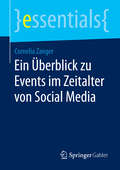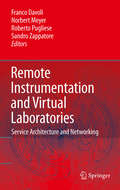- Table View
- List View
Translation Studies on Chinese Films and TV Shows
by Feng YueThis book explores translation strategies for films and TV programs. On the basis of case studies on subtitle translations, it argues that translators are expected to take into consideration not only linguistic and cultural differences but also the limits of time and space. Based on the editor’s experience working as a translator for TV, journalist, and narrator, this book proposes employing editorial translation for TV translation. Further, in light of statistics on international audiences’ views on Chinese films, it suggests striking a balance between conveying cultural messages and providing good entertainment.
ASP.NET 3.5 Tworzenie portali internetowych w nurcie Web 2.0 (in Polish)
by Omar Al ZabirKsika zawiera opis najnowszych metod i technologii projektowania oraz budowy portali z wykorzystaniem platformy ASP.NET i rodowiska ASP.NET AJAX. W podrczniku przedstawiono ...
Talking to Myself: Reflections on Learning to Love Myself and Living Bravely
by Daníela Rivera ZacaríasDaníela Rivera Zacarías believes everything happens for a reason, even if we cannot see it at the moment. This book began as her personal journal, her own attempt to discover her place in the world through analyzing experiences, relationships, and spiritual encounters. It evolved into a book—and then the beloved Hablando Sola brand with more than 2,100,000 Facebook likes—full of thoughtful questions and meaningful reflections that has inspired and uplifted hundreds of thousands of young people in Latin America. Now the book that has sold more than 200,000 copies in Latin America is available in English, coinciding with the brand’s expansion into the United States as Talking to Myself.Zacarías guides readers on their own self-discovery journeys through simple, accessible musings and anecdotes. "How do you learn to love yourself?” she asks and then continues, "I think it’s impossible if you don’t know who you are.” The ensuing chapters include Love, Fear, God, Art, Beauty, Depression, Happiness, and more, tackling a wide range of subjects with one goal in mind: helping readers to better know themselves, that they might better love themselves.This book comes alongside you like a big sister who’s been there and done that and can impart her wisdom between warm hugs and a few laughs. It will be of special interest to the 54 million Hispanic Americans in the United States because of Zacarías’s following in Latin America, but its honesty, warmth, and wisdom will give it broad appeal, particularly to young women.
The Scripps Newspapers Go to War, 1914-18
by Dale ZacherA telling look at the inner workings of one of the nation's most dominant news outlets during wartime In an age before radio and television, E. W. Scripps's ownership of twenty-one newspapers, a major news wire service, and a prominent news syndication service represented the first truly national media organization in the United States. In The Scripps Newspapers Go to War, 1914-18, Dale Zacher details the scope, organization, and character of the mighty Scripps empire during World War I to reveal how the pressures of the market, government censorship, propaganda, and progressivism transformed news coverage during wartime. This volume presents the first systematic look at the daily operations of any major newspaper operation during World War I and provides fascinating accounts of how the papers struggled with competition, their patriotic duties, and internal editorial dissent. The book also engages questions about American neutrality and the newspapers' relationship with President Woodrow Wilson, the move to join the war, and the fallout from the disillusionment of actually experiencing war. Ultimately, Zacher shows how the progressive spirit and political independence at the Scripps newspapers came under attack and was forever changed by this crucial period in American history. A volume in the series The History of Communication, edited by Robert W. McChesney and John C. Nerone
The Cactus and Snowflake at Work: How the Logical and Sensitive Can Thrive Side by Side
by Devora ZackThis hilarious and profound workplace guide proves the rigorously rational and the supremely sympathetic can meet in the middle and merge their strengths. Readers will discover how blending with their opposite opens the pathway to being their truest selves.The famed Myers-Briggs personality scale says that Feelers (who lead with their hearts) put more weight on personal concerns and the people involved, and Thinkers (who lead with their heads) are guided by objective principles and impartial facts. This book calls them Cacti and Snowflakes—each singularly transcendent. But can people with such fundamentally different ways of making sense of and engaging with the world work together?Yes, says Devora Zack! The key is not to try to change each other. Zack says we can directly control only three things: what we say, what we think, and what we do. The best use of our energy is to focus on our own reactions and perceptions rather than try to "fix" other people. This book includes an assessment so readers can learn where they are on the Thinker/Feeler spectrum—and because it's a spectrum, readers might well be a snowcactus or a cactusflake. Then Zack helps them figure out where other people might be, guiding them through a myriad of modes of communication and motivation based on personality type. She includes real-life scenarios that show how to nurture one's nature while successfully connecting with those on the other side.As always, Zack fearlessly and entertainingly dispels myths, squashes stereotypes, and transforms perceived liabilities into strengths. And she once again affirms that, like chocolate and peanut butter, we are better together.
Networking for People Who Hate Networking: A Field Guide For Introverts, the Overwhelmed, and the Underconnected
by Devora ZackWould you rather get a root canal than face a group of strangers? Does the phrase &“working a room&” make you want to retreat to yours? Devora Zack, an avowed introvert and successful consultant who gives presentations to thousands of people at dozens of events annually, feels your pain. She found that other networking books assume that to succeed, you have to act like an extrovert. Not at all. There is another way. Zack politely examines and then smashes to tiny fragments the &“dusty old rules&” of standard networking advice. She shows how the very traits that make many people hate networking can be harnessed to forge an approach more effective and user-friendly than traditional techniques. This edition adds new material on applying networking principles in personal situations, handling interview questions, following up—what do you do with all those business cards?—and more. Networking enables you to accomplish the goals that are most important to you. But you can't adopt a style that goes against who you are—and you don't have to. As Zack writes, &“You do not succeed by denying your natural temperament; you succeed by working with your strengths.&”
Tomorrow’s History: Selected Writings of Simon Zadek, 1993-2003
by Simon ZadekThe last ten years have seen an extraordinary transformation in how business has to account for itself. Today, the air is thick with the buzz of corporate responsibility (CR) leaders, innovators and practitioners. Conferences and publications on the topic are in abundance: the tip of an iceberg that has become a fast-growth industry. Many of those companies and service providers most vocal in distancing themselves from early experimentation have proved the strongest advocates of sustainability reporting, often winning applause and coveted awards in the process. Even companies from controversial sectors such as alcohol, cigarettes and gambling have joined the party – running up bills of tens of millions of dollars in demonstrating their new-found faith for CR. It has not always been like this. As one of the architects of the burgeoning CR movement, Simon Zadek has always been a prolific writer and contributor of ideas. The evolution of his thoughts on new economics, corporate accountability, stakeholder dialogue, social and ethical auditing and reporting have attracted consistent attention – never more than today. In this unique anthology, Zadek crystallises his key work from the last decade into a coherent and fascinating whole, which, read together, provide a context, lens and early history lesson on how CR has become one of the defining business issues of the 21st century. The writings reflect Zadek's involvement with organisations such as the New Economics Foundation, a pioneer in the development of social auditing, sustainability indicators, community finance and much more. They illustrate his contribution in setting up the Ethical Trading Initiative, and AccountAbility (where he is presently the CEO), in working with companies such as The Body Shop and Ben & Jerry's through to Nike, BT and many other civil-society organisations. The book contains 33 pieces, which are split into six sections: "The Economics of Utopia"; "Civil Society, Power and Accountability"; "Accounting for Change"; "The Civil Corporation"; "Partnership Alchemy"; and "Responsible Competitiveness". It will be an invaluable resource for anyone wishing develop an understanding of why corporate responsibility is where it is today and where it might end up tomorrow.
Quality of Experience Modeling for Cloud Gaming Services (T-Labs Series in Telecommunication Services)
by Saman ZadtootaghajThis book presents the development of a gaming quality model to predict the gaming Quality of Experience (QoE) of players that could be used for planning the network service or quality monitoring of cloud gaming services. The author presents a model that is developed following a modular structure approach that keeps the different types of impairments separately. The book shows how such a modular structure allows developing a sustainable model as each component can be updated by advances in that specific research area or technology. The presented gaming quality model takes into account two modules of video quality and input quality. The latter considers the interactivity aspects of gaming. The video quality module offers a series of models that differ depending on the level of access to the video stream information, allowing high flexibility for service providers regarding the positions of measuring points within their system. In summary, the present book focuses on (1) creation of multiple image/video and cloud gaming quality datasets, (2) development of a gaming video classification, and (3) development of a series of gaming QoE models to predict the gaming QoE depending on the level of access to the video stream information.
Social Media Mining
by Reza Zafarani Mohammad Ali Abbasi Huan LiuSocial media shatters the barrier to communicate anytime anywhere for people of all walks of life. The publicly available, virtually free information in social media poses a new challenge to consumers who have to discern whether a piece of information published in social media is reliable. For example, it can be difficult to understand the motivations behind a statement passed from one user to another, without knowing the person who originated the message. Additionally, false information can be propagated through social media, resulting in embarrassment or irreversible damages. Provenance data associated with a social media statement can help dispel rumors, clarify opinions, and confirm facts. However, provenance data about social media statements is not readily available to users today. Currently, providing this data to users requires changing the social media infrastructure or offering subscription services. Taking advantage of social media features, research in this nascent field spearheads the search for a way to provide provenance data to social media users, thus leveraging social media itself by mining it for the provenance data. Searching for provenance data reveals an interesting problem space requiring the development and application of new metrics in order to provide meaningful provenance data to social media users. This lecture reviews the current research on information provenance, explores exciting research opportunities to address pressing needs, and shows how data mining can enable a social media user to make informed judgements about statements published in social media. Table of Contents: Information Provenance in Social Media / Provenance Attributes / Provenance via Network Information / Provenance Data
Producing Graphic Media for Sports: New Horizons and Possibilities for the Motion Media Specialist
by John S. ZaffutoProducing Graphic Media for Sports: New Horizons and Possibilities for the Motion Media Specialist explores the origins, applications, and future of the production of sports-oriented motion graphics. Beginning with the evolution and development of sports-oriented art and design, this book investigates the importance of motion graphics within a variety of environments in the sphere of organized, competitive activity. Venue-based presentation, broadcast and streaming environments, and the importance of graphic standards and brand guidelines are all discussed in detail, along with applications within social media and mobile platforms. A final chapter on emerging technologies covers the potential use of motion media for e-sports and other trending developments within the sports world. The author draws on case studies and interviews with sports media professionals to augment his own research and observation of trends and processes and to highlight the exciting career opportunities that exist within the sports presentation and marketing industries. This book is recommended reading for students of advanced media production, sports marketing, and media production for advertising.
Essential Knowledge for the Aspiring Media Professional
by John Stephen ZaffutoEssential Knowledge for the Aspiring Media Professional provides readers with the skillset needed to produce professional, high-quality video content in today’s competitive media landscape. The author draws on over two decades of industry experience to offer strategies for how to develop a sense of design, adopt a holistic approach to the media production process, and craft a distinct idea for a project’s intent and form. In five in-depth chapters, the book delves into topics ranging from pre-production and planning processes to technical considerations and post-production methods. It concludes with an overview of career opportunities for aspiring media-makers. This book is an invaluable resource for students and professionals alike looking to hone creative production techniques within a broad range of formats and environments, particularly those requiring effective marketing and advertising-oriented content.
Los demasiados libros
by Gabriel ZaidHay en la experiencia de leer una felicidad y libertad que resultan adictivas. La lectura libera. Se extiende a leer la vida, a leer quiénes somos y en dónde estamos. Anima las conversaciones de lector a lector. Se contagia por los lectores en acción: padres, maestros, amigos, escritores, traductores, críticos, editores, tipógrafos, libreros, bibliotecarios y otros promotores del vicio de leer. Gabriel Zaid es capaz de observar el mundo de las letras desde la perspectiva otorgada por otras disciplinas. Su gran acierto es la virtud del poeta: decir lo que oscuramente habíamos intuido sin alcanzar a formularlo en palabras. Señala que el verdadero problema del libro es que el estrato privilegiado que ha hecho estudios universitarios no lee: nunca le ha dado el golpe a la lectura, nunca ha llegado a saber realmente lo que es leer. Esto, que sepamos, nadie lo había dicho.
Mil palabras
by Gabriel ZaidMuchas palabras llaman la atención por sí mismas. Despiertan la curiosidad, los comentarios y luego el uso intencionado. En todas las lenguas hay juegos de palabras, chistes basados en un doble sentido y observaciones lingüísticas. En los periódicos, la radio, la televisión y la web hay secciones dedicadas a comentar palabras. Muchos lectores resuelven crucigramas o pruebas sobre el significado de una palabra. Los diccionarios se inventaron hace más de 4,000 años. Éste es un libro para aficionados a observar palabras, como los hay que observan pájaros. Comenta más de un millar por el simple gusto de hacerlo. Se puede leer de cabo a rabo o en cualquier orden. Comparte con el lector curioso la felicidad de observar. La lista de más de 200 diccionarios consultados es una guía de interés para el lector y permite simplificar su mención en los capítulos correspondientes. Hay aparte una lista platicada de los diccionarios especialmente recomendables. Y un índice alfabético de las palabras comentadas. De Gabriel Zaid hemos publicado una docena de libros en la colección Debolsillo.
Reluctant Power: Networks, Corporations, and the Struggle for Global Governance in the Early 20th Century (Information Policy)
by Rita ZajaczHow early twentieth-century American policymakers sought to gain control over radiotelegraphy networks in an effort to advance the global position of the United States.In Reluctant Power, Rita Zajácz examines how early twentieth century American policymakers sought to gain control over radiotelegraphy networks in an effort to advance the global position of the United States. Doing so, she develops an analytical framework for understanding the struggle for network control that can be applied not only to American attempts to establish a global radio network in the early twentieth century but also to current US efforts to retain control of the internet.In the late nineteenth century, Britain was seen to control both the high seas and the global cable communication network under the sea. By the turn of the twentieth century, Britain's geopolitical rivals, including the United States, looked to radiotelegraphy that could circumvent Britain's dominance. Zajácz traces policymakers' attempts to grapple with both a new technology—radiotelegraphy—and a new corporate form: the multinational corporation, which managed the network and acted as a crucial intermediary. She argues that both foreign policy and domestic radio legislation were shaped by the desire to harness radiotelegraphy for geopolitical purposes and reveals how communication policy and aspects of the American legal system adjusted to the demands of a rising power. The United States was a reluctant power during the early twentieth century, because policymakers were unsure that companies headquartered in the United States were sufficiently American and doubted that their strategies served the national interest.
Chicago Portraits
by Michael Zajakowski Rick Kogan Chicago Tribune StaffThe Chicago Tribune possesses a vast photo archive spanning its more than 150 years in publication. From the Civil War era through today, its photographers have captured thousands of people, from everyday Chicagoans to visitors to the Second City to well-known artists, athletes, and politicians.For the first time, the best of these great photographic portraits are being collected in a large-format coffee-table edition. Chicago Portraits comprises the most memorable of the innumerable images that some of the greatest photographers in journalism have created over the past century. It's a unique showcase for the unsung photographers who've quietly documented daily life in Chicago, and through their decades of work created an unparalleled panorama of the City of Big Shoulders.Curated by the Tribune's photography directors and compiled in a beautiful sewn hardback edition, this will be an engrossing visual cross-section of Chicago life that will be pored over by readers young and old for years to come. Chicago Portraits is a fascinating and colorful look into the lives and legacies that make up this great American city.
Understanding Analog Side Channels Using Cryptography Algorithms
by Alenka Zajić Milos PrvulovicThis book offers the latest research results on analog side channels and their usage in cybersecurity. It demystifies analog side channels and demonstrates new use cases for them. The first part of this book discusses how analog side channels are generated, the physics behind it, the modeling and measurements of analog side channels, and their analogies to wireless communication systems. The second part of this book introduces new applications that benefit from leveraging side channels. In addition to breaking cryptography algorithms, it demonstrates how analog side channels can be used for malware detection, program profiling, hardware profiling, hardware/software attestation, hardware identification, and hardware Trojan detection.Side channel is one of the methods for obtaining information about program execution. Traditionally, they are used in computer science to extract information about a key in cryptographic algorithms. What makes them different from other ways of extracting information about program execution is that side channels rely on how a system implements program execution, rather than what the program’s algorithm specifies. Analog side channels are particularly powerful because they are not easy to suppress or detect that someone is collecting information from the system. Although they are very powerful tools, they are poorly understood.This book targets advanced level students in computer science and electrical engineering as a textbook. Researchers and professionals working with analog side channels, how to model them, measure them, improve signal to noise ratio, and invent new signal processing techniques can also use this book. Computer scientists and engineers who want to learn new applications of side channels to improve system security, new techniques for breaking cryptography keys, new techniques for attestation, and new techniques for hardware Trojan detection will also want to purchase this book.
Telecom Tensions: Internet Service Providers and Public Policy in Canada
by Mike ZajkoToday's internet service providers mediate communication, control data flow, and influence everyday online interactions. In other words, they have become ideal agents of public policy and instruments of governance. In Telecom Tensions Mike Zajko considers the tensions inherent to this role – between private profits and the public good, competition and cooperation, neutrality and discrimination, surveillance and security – and asks what consequences arise from them.Many understand the internet as a technology that cuts out traditional gatekeepers, but as the importance of internet access has grown, the intermediaries connecting us to it have come to play an increasingly vital role in our lives. Zajko shows how the individuals and organizations that keep these networks running must satisfy a growing number of public policy objectives and contradictory expectations. Analyzing conflicts in Canadian policy since the commercialization of the internet in the 1990s, this book unearths the roots of contemporary debates by foregrounding the central role of internet service providers. From downtown data centres to publicly funded rural networks, Telecom Tensions explores the material infrastructure, power relations, and political aspirations at play.Theoretically informed but grounded in the material realities of people and places, Telecom Tensions is a fresh look at the political economy of telecommunications in Canada, updating conversations about liberalization and public access with contemporary debates over privacy, copyright, network neutrality, and cyber security.
The War for Kindness: Building Empathy in a Fractured World
by Jamil Zaki'In this masterpiece, Jamil Zaki weaves together the very latest science with stories that will stay in your heart forever' - Angela Duckworth, author of Grit 'Scientific, gripping, groundbreaking and hopeful. The War for Kindness is the message for our times' - Carol Dweck, author of Mindset Empathy has been on people's mind a lot lately. Philosophers, evolutionary scientists and indeed former President Obama agree that an increase in empathy could advance us beyond the hatred, violence and polarization in which the world seems caught. Others disagree, arguing it is easiest to empathize with people who look, talk or think like us. As a result, empathy can inspire nepotism, racism and worse. Having studied the neuroscience and psychology of empathy for over a decade, Jamil Zaki thinks both sides of this debate have a point. Empathy is sometimes an engine for moral progress, and other times for moral failure. But Zaki also thinks that both sides are wrong about how empathy works. Both scientists and non-scientists commonly argue that empathy is something that happens to you, sort of like an emotional knee-jerk reflex. Second, they believe it happens more to some people than others. This lines people up along a spectrum, with deep empaths on one end and psychopaths on the other. What's more, wherever we are on that spectrum, we're stuck there. In The War for Kindness, Zaki lays out a very different view of how empathy works, one that breaks these two assumptions. Empathy is not a reflex; it's a choice. We choose empathy (or apathy) constantly: when we read a tragic novel, or cross the street to avoid a homeless person, or ask a distraught friend what's the matter. This view has crucial consequences: if empathy is less a trait (like height), and more a skill (like being good at word games), then we can improve at it. By choosing it more often, we can flex our capabilities and grow more empathic over time. We can also "tune" empathy, ramping it up in situations where it will help and turning it down when it might backfire. Zaki takes us from the world of doctors who train medical students to empathise better to social workers who help each other survive empathising too much. From police trainers who help cadets avoid becoming violent cops to political advocates who ask white Americans to literally walk a (dusty) mile in Mexican immigrants' shoes. This book will give you a deepened understanding of how empathy works, how to control it and how to become the type of empathiser you want to be.
The War for Kindness: Building Empathy in a Fractured World
by Jamil Zaki'In this masterpiece, Jamil Zaki weaves together the very latest science with stories that will stay in your heart forever' - Angela Duckworth, author of Grit'Scientific, gripping, groundbreaking and hopeful. The War for Kindness is the message for our times' - Carol Dweck, author of MindsetEmpathy has been on people's mind a lot lately. Philosophers, evolutionary scientists and indeed former President Obama agree that an increase in empathy could advance us beyond the hatred, violence and polarization in which the world seems caught. Others disagree, arguing it is easiest to empathize with people who look, talk or think like us. As a result, empathy can inspire nepotism, racism and worse. Having studied the neuroscience and psychology of empathy for over a decade, Jamil Zaki thinks both sides of this debate have a point. Empathy is sometimes an engine for moral progress, and other times for moral failure. But Zaki also thinks that both sides are wrong about how empathy works. Both scientists and non-scientists commonly argue that empathy is something that happens to you, sort of like an emotional knee-jerk reflex. Second, they believe it happens more to some people than others. This lines people up along a spectrum, with deep empaths on one end and psychopaths on the other. What's more, wherever we are on that spectrum, we're stuck there. In The War for Kindness, Zaki lays out a very different view of how empathy works, one that breaks these two assumptions. Empathy is not a reflex; it's a choice. We choose empathy (or apathy) constantly: when we read a tragic novel, or cross the street to avoid a homeless person, or ask a distraught friend what's the matter. This view has crucial consequences: if empathy is less a trait (like height), and more a skill (like being good at word games), then we can improve at it. By choosing it more often, we can flex our capabilities and grow more empathic over time. We can also "tune" empathy, ramping it up in situations where it will help and turning it down when it might backfire. Zaki takes us from the world of doctors who train medical students to empathise better to social workers who help each other survive empathising too much. From police trainers who help cadets avoid becoming violent cops to political advocates who ask white Americans to literally walk a (dusty) mile in Mexican immigrants' shoes. This book will give you a deepened understanding of how empathy works, how to control it and how to become the type of empathiser you want to be.
South Picene (Routledge World Languages)
by Raoul ZamponiSouth Picene is the pre-Roman language spoken in the Adriatic sector of central Italy. This book presents a description of what we know about the structure of this language. South Picene is (together with Umbrian, Oscan, Latin, and Faliscan) one of the few members of the Italic branch of the Indo-European family and is also one of the European languages with the oldest existing texts (550 BCE). Besides a grammatical outline of the language, the book contains the linguistic (and often stylistic) analysis of all the 21 inscriptions that compose the South Picene epigraphic corpus and a word list. South Picene will be of interest to students and scholars of Indo-European languages, Italic languages, and in general, ancient languages of the Italian peninsula.
Infinite Words: A Comprehensive Guide to Writing and Publishing
by ZaneNew York Times bestselling author Zane shares the lessons she's learned over the years about successful book publishing, filmmaking, and TV production.Drawing on decades of experience as a mega-bestselling novelist, successful publisher, and executive producer of two TV shows, Zane offers practical advice on writing and publishing to aspiring writers across all media, including books, TV, and film. With her signature wit and straightforward style, Zane tells it like it is, emphasizing hard work, discipline, and commitment as the keys to a successful writing career. Part One covers the writing and creative process, including how to define your writing style, how to outline a story, how to develop characters, typical mistakes to avoid, writing for your medium, and the revision process. Part Two covers the book publishing process, from finding a literary agent who best understands your work, to getting your work in the hands of publishers, to building an audience for your work. Zane also shares wisdom from her early years as a self-published author for those seeking an alternative to traditional publishing. Infinite Words isn't just a reference guide; it's an essential companion for writers facing the unique challenges and opportunities of today's ever-evolving world.
Pervasive Mobile and Ambient Wireless Communications
by Alberto Zanella Roberto VerdonePervasive Mobile and Ambient Wireless Communications reports the findings of COST 2100, a project of the European intergovernmental COST framework addressing various topics currently emerging in mobile and wireless communications. Drawing on experience developed in this and earlier COST projects, the text represents the final outcome of collaborative work involving more than 500 researchers in 140 institutions and 30 countries (including outside Europe). The book's subject matter includes: transmission techniques; signal processing; radio channel modelling and measurement; radio network issues; and recent paradigms including ultra-wideband, cooperative, vehicle-to-vehicle and body communications. The research reported comes from a variety of backgrounds: academic, equipment-manufacturing and operational and the information contained in this book will bring the study reported to a wider audience from all those spheres of work. Pervasive Mobile and Ambient Wireless Communications will be of interest to researchers for its cutting-edge analysis and to practitioners for its functional usability.
The Routledge Handbook of Translation and Methodology (Routledge Handbooks in Translation and Interpreting Studies)
by Federico ZanettinThe Routledge Handbook of Translation and Methodology provides a comprehensive overview of methodologies in translation studies, including both well-established and more recent approaches. The Handbook is organised into three sections, the first of which covers methodological issues in the two main paradigms to have emerged from within translation studies, namely skopos theory and descriptive translation studies. The second section covers multidisciplinary perspectives in research methodology and considers their application in translation research. The third section deals with practical and pragmatic methodological issues. Each chapter provides a summary of relevant research, a literature overview, critical issues and topics, recommendations for best practice, and some suggestions for further reading. Bringing together over 30 eminent international scholars from a wide range of disciplinary and geographical backgrounds, this Handbook is essential reading for all students and scholars involved in translation methodology and research.
Ein Überblick zu Events im Zeitalter von Social Media (essentials)
by Cornelia ZangerDie explosionsartige Entwicklung der digitalen Vernetzung hat auch dieKommunikationspolitik von Unternehmen verändert. Social-Media-Kommunikation beeinflusst das Eventmarketing und bietet ein großes Potenzial für die Verbindung von multisensualen Erlebnissen mit einer Erhöhung der Reichweite von Events. Nach dem Grad der Intensität der Verbindung von realen Events und Social Media sind verschiedene Eventtypen zu ermitteln. Im Beitrag werden sowohl virtuelle Events im engeren Sinne als auch sogenannte hybride Events, bei denen reale Events mit Social-Media-Elementen verbunden sind, betrachtet.
Remote Instrumentation and Virtual Laboratories
by Sandro Zappatore Norbert Meyer Roberto Pugliese Franco DavoliAccessing remote instrumentation worldwide is one of the goals of e-Science. The task of enabling the execution of complex experiments that involve the use of distributed scientific instruments must be supported by a number of different architectural domains, which inter-work in a coordinated fashion to provide the necessary functionality. These domains embrace the physical instruments, the communication network interconnecting the distributed systems, the service oriented abstractions and their middleware. The Grid paradigm (or, more generally, the Service Oriented Architecture -- SOA), viewed as a tool for the integration of distributed resources, plays a significant role, not only to manage computational aspects, but increasingly as an aggregator of measurement instrumentation and pervasive large-scale data acquisition platforms. In this context, the functionality of a SOA allows managing, maintaining and exploiting heterogeneous instrumentation and acquisition devices in a unified way, by providing standardized interfaces and common working environments to their users, but the peculiar aspects of dealing with real instruments of widely different categories may add new functional requirements to this scenario. On the other hand, the growing transport capacity of core and access networks allows data transfer at unprecedented speed, but new challenges arise from wireless access, wireless sensor networks, and the traversal of heterogeneous network domains. The book focuses on all aspects related to the effective exploitation of remote instrumentation and to the building complex virtual laboratories on top of real devices and infrastructures. These include SOA and related middleware, high-speed networking in support of Grid applications, wireless Grids for acquisition devices and sensor networks, Quality of Service (QoS) provisioning for real-time control, measurement instrumentation and methodology, as well as metrology issues in distributed systems.

